Rural Scotland Key Facts 2021
Biennial compendium publication comparing and contrasting statistics on key policy topics such as People and Communities, Services and Lifestyle, Economy and Enterprise broken down by Remote Rural, Accessible Rural and the Rest of Scotland.
Economy and Enterprise

Industry
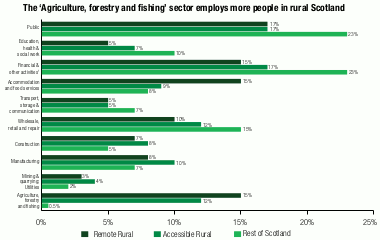
Source: Inter Departmental Business Register, as at March 2020 (Using Scottish Government Urban Rural Classification 2016)
Notes:
1. ‘Financial & other activities’ consists of: ‘Financial and insurance activities’, ‘Real estate activities’, ‘Professional, scientific and technical activities’, ‘Administrative and support service activities’ and ‘Arts, entertainment and recreation; Other service activities’.
Figure 12 shows the distribution of employment across sectors, with workers in the Public sector shown as a single category. ‘Agriculture, forestry and fishing’ is the sector that shows the greatest difference across Scotland, accounting for 15% of workers in remote rural areas compared to 12% in accessible rural areas and 0.5% in the rest of Scotland. The ‘Accommodation and food services’ sector also has a much larger share of employment in remote rural areas (15%) compared to accessible rural areas (9%) and the rest of Scotland (8%).
In all areas of Scotland the Public sector is the largest employing sector. For accessible rural areas and the rest of Scotland the ‘Financial & other activities’ sector has the same proportion of employment as the Public sector.
In remote rural areas the ‘Agriculture, forestry and fishing’, ‘Accommodation and food services’ and the ‘Financial & other activities’ sectors are the largest source of private sector jobs (15% each). Following the ‘Financial & other activities’ (17%), the largest sources of private sector jobs in accessible rural areas area are the ‘Agriculture, forestry and fishing’ (12%), ‘Wholesale, retail and repair’ (12%) and ‘Manufacturing (10%)’ sectors.’

Business
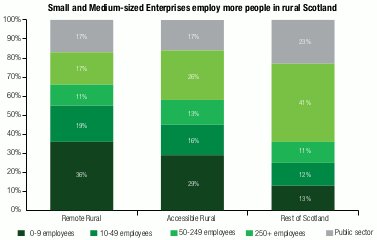
Source: Inter Departmental Business Register, as at March 2020 (Using Scottish Government Urban Rural Classification 2016)
Figure 13 shows that Micro businesses (0-9 employees) account for 36% of employment in remote rural areas and 29% in accessible rural areas, while they only account for 13% of employment in the rest of Scotland. Overall, Small and Medium-sized Enterprises (0-249 employees), which include Micro businesses, account for two thirds of employment in remote rural areas compared to 58% in accessible rural areas. The proportion falls to 36% in the rest of Scotland.
Large businesses (250+ employees) account for 41% of those employed in the rest of Scotland. This compares to 26% in accessible rural areas and 17% in remote rural areas.

| Remote Rural | Accessible Rural | Rest of Scotland | |
|---|---|---|---|
| Agriculture, forestry and fishing | 35% | 26% | 2% |
| Mining & quarrying; Utilities | 1% | 1% | 1% |
| Manufacturing | 5% | 5% | 5% |
| Construction | 11% | 12% | 12% |
| Wholesale, retail and repair | 10% | 10% | 15% |
| Transport, storage & communication | 5% | 7% | 11% |
| Accommodation and food services | 9% | 5% | 9% |
| Financial & other activities1 | 22% | 31% | 40% |
| Education, health & social work | 3% | 3% | 6% |
| Public | 0% | 0% | 0% |
| Total | 100% | 100% | 100% |
Source: Inter Departmental Business Register, as at March 2020 (Using Scottish Government Urban Rural Classification 2016)
Notes:
1. ‘Financial & other activities’ consists of: ‘Financial and insurance activities’, ‘Real estate activities’, ‘Professional, scientific and technical activities’, ‘Administrative and support service activities’ and ‘Arts, entertainment and recreation; Other service activities’.
Table 26 shows in which industry sectors Small and Medium Enterprises (SMEs) operate, across the 3-fold Urban Rural categories. The sector that has the largest difference between rural areas and the rest of Scotland is the ‘Agriculture, forestry and fishing’ sectors. In remote rural areas, 35% of SMEs are in this sector and 26% are in accessible rural areas, this compares to 2% in the rest of Scotland. Whereas, for rest of Scotland 40% of SMEs are in the ‘Financial & other activities’ sector compared to 31% of SMEs in accessible rural areas and 22% of SMEs in remote rural areas.
The total number of SMEs (registered for VAT and/or PAYE) operating in remote rural areas, accessible rural areas and the rest of Scotland as at March 2020 were 19,520, 29,230 and 129,290 respectively.

| Remote Rural | Accessible Rural | Rest of Scotland | |
|---|---|---|---|
| Higher managerial and professional occupations | 12% | 19% | 16% |
| Lower managerial and professional occupations | 25% | 26% | 29% |
| Intermediate occupations | 10% | 12% | 14% |
| Small employers and own account workers | 19% | 13% | 8% |
| Lower supervisory and technical occupations | 10% | 8% | 9% |
| Semi-routine occupations | 15% | 12% | 14% |
| Routine occupations | 10% | 10% | 11% |
| Total | 100% | 100% | 100% |
Source: Annual Population Survey in Scotland, January to December 2019, ONS (using the Scottish Government Urban Rural Classification 2016)
For all areas of Scotland the highest proportion of the population (aged 16 to 74) in employment work in lower managerial and professional occupations. The proportion is highest in the rest of Scotland (29%), then accessible rural areas (26%) and finally remote rural areas (25%). The proportion of people who are employed in higher managerial and professional positions is highest in accessible rural areas (19%). This compares to 16% in the rest of Scotland and 12% in remote rural areas.
A greater proportion of workers in remote rural areas (19%) are small employers or own account workers than in accessible rural areas (13%) or the rest of Scotland (8%).

| Remote Rural | Accessible Rural | Rest of Scotland | |
|---|---|---|---|
| Total businesses | 14,960 | 28,095 | 140,430 |
| Business openings | 1,235 | 2,775 | 17,655 |
| Business opening rate | 8% | 10% | 13% |
| Business closures | 1,245 | 2,595 | 15,575 |
| Business closure rate | 8% | 9% | 11% |
| Total businesses per 10,000 adults | 473 | 456 | 310 |
| Business openings per 10,000 adults | 39 | 45 | 39 |
| Net business openings and closures | -10 | 180 | 2,080 |
| Net business openings and closures as % of total businesses | -0.1% | 1% | 1% |
Source: Inter Departmental Business Register (ONS) 2019 (Using Scottish Government Urban Rural Classification 2016)
Table 28 shows the number of business openings and closures as measured by the number registering for either VAT or PAYE. It therefore excludes businesses with no employees and a turnover below the VAT threshold, which has been £85,000 since 1 April 2017.
During 2019 more business opened than closed in accessible rural areas and the rest of Scotland, in contrast to remote rural areas where more businesses closed than opened. In terms of rates, the lowest rate of business openings was seen in remote rural areas (8%), with the highest in the rest of Scotland (13%). Business closure rates were also lowest in remote rural areas (8%) and highest in the rest of Scotland (11%).
The net business openings and closures as a percentage of total businesses was 1% in both accessible rural areas and the rest of Scotland. For remote rural areas, the net business openings and closures as a percentage of total businesses was -0.1%, a net decrease of just 10 businesses.
Within the Fair Work and Business National Outcome of the National Performance Framework there is a National Indicator called the Number of Businesses, which measures the total number of VAT/PAYE registered private sector enterprises operating in Scotland per 10,000 adults.

Economic Activity
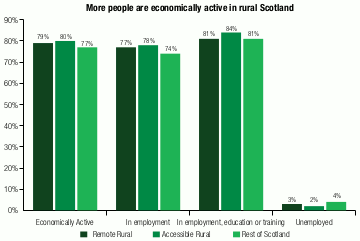
Source: Annual Population Survey in Scotland, January to December 2019, ONS (Using the Scottish Government Urban Rural Classification 2016)
Notes:
1. Levels of employment and unemployment in the figure are for those aged 16 to 64. The unemployment rate is calculated as a proportion of those aged 16 to 64 and who are economically active while the other rates are calculated as a proportion of the total population who are within this age grouping. This differs from standard International Labour Organisation definitions: the employment level is for those aged 16 and above while the unemployment level and rate are also for this age range, with the rate calculated as a proportion of those who are economically active.
Figure 14 shows that more people are economically active in rural Scotland. People who are employed or looking for work are economically active. The rate of economic activity, the employment rate (the number of people employed as a percentage of the total population of working age) and the rate of the working age population that is either employed, in education or training are all highest in accessible rural areas.
Unemployment rates are broadly similar across all areas of Scotland. They range from 2% in accessible rural areas to 4% in the rest of Scotland.
The total number of people employed in remote rural areas, accessible rural areas and the rest of Scotland are 128,700, 310,800 and 2,135,300 respectively.

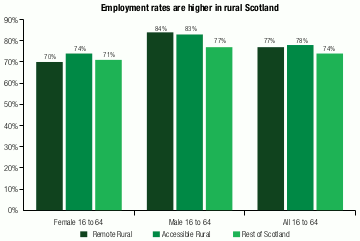
Source: Annual Population Survey in Scotland, January to December 2019, ONS (Using the Scottish Government Urban Rural Classification 2016)
Figure 15 shows that the employment rates are mostly higher in rural areas compared to the rest of Scotland. The one exception is for females aged 16 to 64, where the employment rate in remote rural areas is one percentage point lower than in the rest of Scotland at 70%.
For females aged 16 to 64 the highest employment rate is in accessible rural areas (74%), while for males aged 16 to 64 the highest employment rate is in remote rural areas (84%). The employment rates for males aged 16 to 64 are higher than for females aged 16 to 64 in all areas of Scotland.

| Remote Rural | Accessible Rural | Rest of Scotland | ||
|---|---|---|---|---|
| Percentage of employed females who are: | Self-employed | 16% | 15% | 8% |
| Working part-time in main job | 46% | 46% | 40% | |
| With a second job | 10% | 5% | 4% | |
| Homeworkers2 | 12% | 10% | 4% | |
| Percentage of employed males who are: | Self-employed | 29% | 19% | 14% |
| Working part-time in main job | 12% | 12% | 13% | |
| With a second job | 6% | 3% | 3% | |
| Homeworkers2 | 10% | 9% | 3% | |
| Percentage of all employed who are: | Self-employed | 23% | 17% | 11% |
| Working part-time in main job | 28% | 28% | 26% | |
| With a second job | 8% | 4% | 3% | |
| Homeworkers2 | 11% | 9% | 4% |
Source: Annual Population Survey in Scotland, January to December 2019, ONS (Using Scottish Government Urban Rural Classification 2016)
Notes:
1. Includes all workers aged 16 and over.
2. Homeworkers are people who work mainly in their own home or in the same grounds or buildings as home, in their main job. Excludes people on government employment and training schemes.
Table 29 shows that self-employment is common in rural Scotland than in the rest of Scotland. This is particularly true for remote rural areas. In all areas of Scotland men are more likely to be self-employed than women.
Women are considerably more likely than men to work part-time in all areas of Scotland, with at least 40% of women who are employed working part-time in all areas of Scotland. Employees in remote rural areas, particularly women, are more likely to have a second job than in accessible rural areas or the rest of Scotland.
The percentage of employed people in remote rural areas who have a second job (8%) is more than double that of employed people in in the rest of Scotland (3%). A higher proportion of employed people in rural areas are ‘homeworkers’ compared to the rest of Scotland. This is the case for both women and men.

Earnings
| Remote Rural | Accessible Rural | Rest of Scotland | |
|---|---|---|---|
| Female | £14.29 | £16.27 | £15.20 |
| Male | £14.14 | £16.19 | £15.98 |
| All | £14.19 | £16.26 | £15.65 |
Source: Annual Survey of Hours and Earnings 2020 (Using the Scottish Government Urban Rural Classification 2016)
Notes:
1. Employees aged 16+ on the PAYE system on adult rates (including those furloughed under the Coronavirus Job Retention Scheme) and whose pay was not affected by absence.
2. The colour coding indicates the quality of each estimate. The quality of an estimate is measured by its coefficient of variation (CV). Further information on the colour coding used can be found in Sources in the Notes section at the end of this publication.
Table 30 shows the median hourly wage rate for all female and male employees residing in each of the 3-fold Urban Rural categories. In rural areas the median wage for females is higher than that for males, while in the rest of Scotland the male median wage is higher. The median wage for both females and males is highest in accessible rural areas.
The largest differences in median hourly rates of pay for both females than males is between accessible rural areas, where the rate is higher, and remote rural areas. The difference for females is £1.98 per hour and for males it is £2.05 per hour.

| Remote Rural | Accessible Rural | Rest of Scotland | |
|---|---|---|---|
| Female | £27,231 | £31,678 | £28,405 |
| Male | £32,021 | £35,556 | £34,044 |
| All | £29,652 | £34,311 | £31,531 |
Source: Annual Survey of Hours and Earnings 2020 (Using Scottish Government Urban Rural Classification 2016)
Notes:
1. Employees on adult rates who have been in the same job for more than a year.
2. The colour coding indicates the quality of each estimate. The quality of an estimate is measured by its coefficient of variation (CV). Further information on the colour coding used can be found in Sources in the Notes section at the end of this publication.
Table 31 shows that the median gross annual pay (i.e. before taxation and other deductions) for all full-time employees is highest for people living in accessible rural areas. This is followed by people living in the rest of Scotland and then finally those living remote rural areas.
In all areas of Scotland the median gross annual pay is higher for males than females. The difference is greatest in the rest of Scotland where the median gross pay for males is £5,639 higher than for females. In remote rural areas the difference is £4,790 and in accessible rural areas the difference is £3,878.

Income
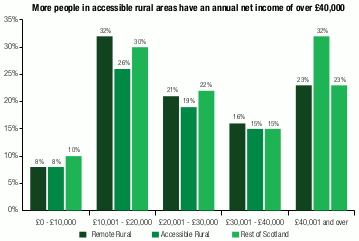
Source: Scottish Household Survey 2019 (Using Scottish Government Urban Rural Classification 2016)
Figure 16 presents the distribution of net household income figures (for the highest income householder) by 3-fold Urban Rural category. The income figures include income from employment, benefits and other sources (after taxation and other deductions).
The most common income bracket for a household in both remote rural areas and the rest of Scotland is the £10,001 to £20,000 category, while in accessible rural areas it is the £40,001 and over category.
The largest differences in proportion between the different areas of Scotland are for households with a net income in the £40,001 and over category. In accessible rural areas the proportion is 32%. This compares to both 23% in remote rural areas and the rest of Scotland.

| Remote Rural | Accessible Rural | Rest of Scotland | |
|---|---|---|---|
| Number income deprived | 25,463 | 44,283 | 584,815 |
| Number employment deprived | 11,841 | 21,972 | 290,978 |
| Percentage of the population that are income deprived | 8% | 7% | 13% |
| Percentage of the working age1 population that are employment deprived | 6% | 6% | 10% |
Source: Scottish Index of Multiple Deprivation 2020. (Using 2017 mid-year population estimates (NRS) and Scottish Government Urban Rural Classification 2016)
Notes:
1. Working age refers to male population aged 16 to 64. For females, the working age population has been transitioning from 60 to be the same as for males. For this indicator, the working age of females is taken as at 30 June 2017, with an adjustment to the NRS mid-year 2017 population estimates to reflect that a small proportion of women aged 63 will not be of pensionable age at that point.
Income deprivation comprises five indicators. They are the number of adults receiving Income Support, income-based Employment and Support Allowance, or Jobseeker’s Allowance, the number of adults receiving Guaranteed Pension Credit, the number of dependent children (aged 0-18) for claimants of Income Support, income-based Employment and Support Allowance, or Jobseeker’s Allowance, people claiming Universal Credit and their dependent children (excluding those in the ‘working with no requirements’ conditionality group), and the number of adults and children in Tax Credit families on low Incomes.
Employment deprivation comprises three indicators that identify those people who are working age that want to work, but due to unemployment, ill health or disability are excluded from the labour market. They are recipients of Jobseeker’s Allowance, recipients of Incapacity Benefit, Employment and Incapacity Benefit, Employment and Support Allowance or Severe Disablement Allowance, and Universal Credit claimants not in employment count.
Table 32 shows that the proportion of the total population that is income deprived is lower in rural areas than the rest of Scotland, with the proportion lowest in accessible rural areas at 7%.
The proportion of the working age population, as defined by the Scottish Index of Multiple Deprivation, that are employment deprived is also lower in rural areas than in the rest of Scotland. In both remote rural and accessible rural areas the proportion of working age population who are employment deprived is 6%.
Contact
Email: RuralStatistics@gov.scot
There is a problem
Thanks for your feedback